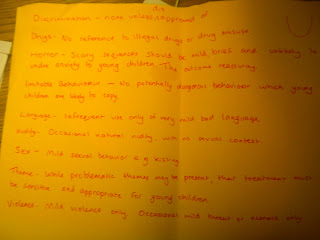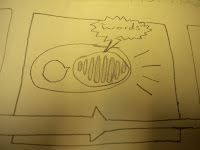In what ways does your media product use, develop or challenge conventions of real media products?
Our product has taken a lot from conventional films in the way that we used our shot types and how we sequenced them. We told a story by mainly switching between two subjects in even order to keep the audience aware of both groups throughout. This was also a good tool to project suspense when needed. We also have the usual “Good guy + Bad guy” scenario, where one or more antagonists are conspiring against one or more protagonists. The genre of our product was based on the holiday of the time, being Halloween. It was initially meant to be somewhat creepier to fit with the theme, but in the end it was more of a generic children’s film, without any particular theme. Our camera work was based more on common knowledge of how things in our product should be displayed rather than direct influence from conventional films. It may be that our perception of what is a sensible camera angle or shot choice is derived from a life of exposure to conventional media. The sound part of our editing, I don’t think was very specifically thought through. We chose a fitting soundtrack to cover the whole sequence, and made sure any dialogue was at optimal optimal voice projection. There wasn’t any real influence there. We used no special effects for our product. The only kind of screen editing we did was the titles moving across the screen. The conventions of an opening sequence in films are generally to give the audience a brief insight into the rest of the film and make them want to watch more by drawing them into the story. We have done this by clearly identifying the characters and their intent. And also showing the surroundings and environment to show where the film will mainly be based. We’ve also used the opening to show the general mood of the film, which is light hearted and not serious, this is also useful for showing who the film will be appropriate for. Another way it could possibly challenge conventions would be that we didn’t include any outside sounds apart from one clip; We only added synthetic outdoors sounds where the music stopped. The music continued through the majority of the sequence with nothing else.
Ways we could have improved this include representing the antagonists and protagonist better visually. By showing the characters in a certain way from the start by clothing or appearance through things like makeup, we could have made it easier for the younger audience to identify straight away who is doing what, or who they should like.
How does your media product represent particular social groups?
All of the characters in our product are male and of the same age, so in a way we are representing the young male social group. The effect of this might be that in the rest of the film, males would be identified as malevolent or mischievous like the boys in the opening because they would be affiliated with them. Our characters are represented this way by their clear intent in the sequence, which is to pull a trick on Max.
A way we could have improved this is by separating the protagonist and antagonists in a way that they represent separate social groups. This could be done with things like clothing, having them talk about each other to show who they like and don’t like, or facial appearances with makeup.
What kind of media institution would you distribute your media production?
I wouldn’t label our product for any particular company, although I wouldn’t say it was a traditional theme, so maybe not something like Disney or Warnerbrothers.
Who would be the audience for your media product?
Our product is going to be rated U, and the target audience will be for children, possibly aged 6-16. I can’t think of any similar products to our own. I wouldn’t say it’s completely unique but it doesn’t resemble anything I’ve seen before.
How did you attract/address your audience?
I think the main way we attracted our audience to continue watching was the build up created by our building sequence; people would want to know what comes next, or if the protagonist escapes. Clues about the narrative aren’t numerous, apart from how we’re introduced to the protagonist and the antagonists, and how it is set in the woods.
What have you learnt about the technologies from the process of constructing your product?
The product has introduced me to several different types of technologies. The first would be the camera and how it is used and set up. Another is the editing software such as final cut and garage band to customise the clip length and sort out the audio.
For example, I learned how to crop video clips with the razor tool in final cut, and how to rise and lower the sound of a clip by raising the slider at the top of the clip rectangle. Specifically, I learnt how to migrate projects from one programme to another, like from Final Cut to Garage band when we wanted to add the audio. There is also learning how to access the student blog on the Long Road website. It took me a little longer to grasp, but now I’m confident I can submit homework to the blog from anywhere.
Ways we could improve the editing process would be to revise how to import files from one programme to another to save time. For example, at one point we were stuck for about 10 minutes because we couldn’t figure out how to move our file from garage band to final cut.
Looking back at your preliminary task, what do you feel you have learnt in the progression from it to your final product?
The second preliminary task was very helpful practice for our opening sequence. Because we only had experience of using the stop motion tools and software, we needed another project that introduced us to camera work and our first look at the editing software as well. Specifically, we learned how to cut up clips and put other clips into them, making for a more intricate scene. It also gave us an idea of our limitations in terms of conversation and dialogue, because in the prelim’, we hadn’t produced a script to use, so when it came to producing the same scene again, we had great difficulties reinacting it accurately. Another technique we gained from the preliminary task was the ability to chose appropriate shots and angles, like the close up on the door handle or the end scene when the camera pans over the classroom.
































